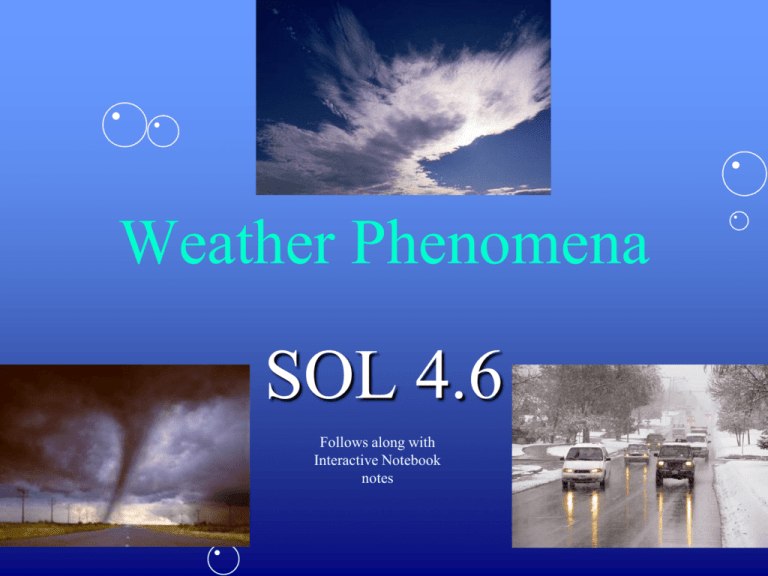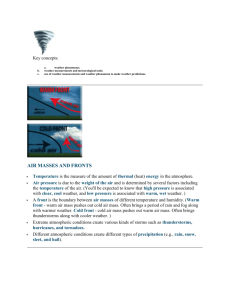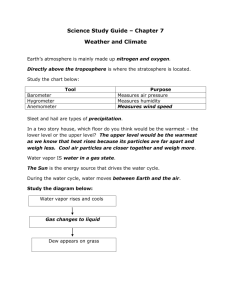Weather Phenomena - Suffolk Public Schools
advertisement

Weather Phenomena SOL 4.6 Follows along with Interactive Notebook notes Temperature Weather Includes: Precipitation Wind Weather Instruments (Tools) Temperature- the measure of the amount of heat energy in the atmosphere Measured using a THERMOMETER Additional Weather Instruments Wind Speed is measured using an ANEMOMETER Wind Direction is measured using a WEATHER VAIN. Additional Weather Instruments A RAIN GAUGE is used to measure the amount of precipitation. Precipitation Includes: Rain Formed by ice crystals* Snow More types of Precipitation: Sleet Mixture of snow and rain Formed by ice crystals* Hail Air Masses and Fronts Air Masses: formed when air in the atmosphere is heated at the equator and cooled at the poles. Fronts: formed when two air masses of different temperatures and humidity* bump into each other. *Humidity is the amount of water vapor in the air. Types of Fronts Cold air mass pushes into a warm air mass. Cold front Warm front Warm air mass pushes into a cold air mass. Additional Weather Tools Air pressure is the result of the mass/weight of the air and temperature pushing on its surroundings. (atmospheric pressure) Measured using a BAROMETER Do weather forecasters use air pressure to predict the weather? High pressure areas are formed when air is cooled. Low pressure is formed when air is warmed. Weather associated with low pressure areas are: clouds, rain, and wind. Thunderstorms Storms Tornadoes Hurricanes Thunderstorms Strong winds, heavy rain, thunder, and lightning. Most common in Virginia, but when? How are they formed? Largest Storm on Earth! Form over warm water How do they begin? What are some of the characteristics of a hurricane? Hurricanes Tornados Column of warm air begins to spin upward forming a funnel cloud. What types of wind speed and what can they do? CLOUDS Clouds are formed when warm air carrying water vapor rises from the Earth and the water vapor cools down and connect to each other. Are all clouds the same? Cumulus Fluffy, white clouds with flat bottoms. Cumulus clouds usually indicate fair weather. (Middle) Resemble? Cirrus Feathery, wispy, clouds; associated with fair weather. They often indicate that rain or snow will fall within hours. (High) Made from? Stratus Flat, smooth, gray clouds that blanket/cover the whole sky. (low) What type of weather? Cumulo-nimbus • Foul weather storm clouds that bring heavy rains and thunderstorms. How are they formed? Spot the cloud! Low and flat ….. Stratus Spot the cloud! Middle level, fluffy ….. Cumulus Spot the cloud! High level, wispy ….. Cirrus Spot the cloud! Rain bearing, storm clouds ….. Cumulo-Nimbus Let’s Review It’s time to play the… Cirrus Clouds Cold Front Wind/Weather Vane Thermometer Hurricane High pressure Snow Air Masses Cumulous Clouds Low pressure Precipitation Barometer Sleet Cumulo-nimbus Clouds Hail Rain Gauge Warm Front Air pressure Clouds Thunderstorm Tornado Anemometer Stratus Clouds Weather Meteorologists The ABC’s of Weather Draw a letter from the bag. Share a word or phrase that begins with the letter to summarize weather. Tara Moore, Elementary Lead Science Teacher Suffolk Public Schools October 2005 Some cloud slides adapted from John Harris, Radley College, UK







